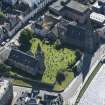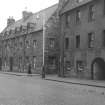Inverness, 86 - 88 Church Street, Dunbar's Hospital
Hospital (17th Century)
Site Name Inverness, 86 - 88 Church Street, Dunbar's Hospital
Classification Hospital (17th Century)
Alternative Name(s) School Lane
Canmore ID 13357
Site Number NH64NE 14
NGR NH 66517 45498
NGR Description NH 66509 45503 to NH 66534 56593
Datum OSGB36 - NGR
Permalink http://canmore.org.uk/site/13357
- Council Highland
- Parish Inverness And Bona
- Former Region Highland
- Former District Inverness
- Former County Inverness-shire
NH64NE 14 66509 45503 to 66534 56593
See also:
(NH 66534550) Dunbar's Hospital in Church Street was bequeathed to the town as a hospital in 1668. It was used as a Grammar School till the opening of the Royal Academy in 1792. It was built with stones from Cromwells' Fort.
T Wallace 1917.
An armorial panel on the building contains Provost Dunbar's coat of arms and the date '1676' The date inscribed above two of the upper windows is 1668.
C Fraser-Mackintosh 1913.
Dunbar's Hospital is in good condition and in use as dwellings and a hall. The armorial panel above the door is a replica of the original which is now in the Museum, Inverness.
Visited by OS (W D J) 1 April 1960.
NH6645 Following the publication of the Scottish Burgh Survey report on Inverness, 7 trial trenches were excavated at strategic points within the medieval burgh:-
Trench 1, on the cleared site of No's 19 and 21 Castle Street.
Trench 2, in the garden of balnain House, on the north bank of the River Ness.
Trench 3, behind No's 43-47 Church Street.
trench 4, in the drying green immediately behind Dunbar's Hospital, Church Street.
Trench 5, behind the municipal swimming baths.
Trench 6, to the south of Abertarff House, Church Street.
Trench 7, on the cleared site of No 10 Market Street.
Of these only trenches 1, 3 and 6 yielded evidence of medieval activity. Trench 1 comprised up to 2m of stratified deposits, trench 3 contained a number of clay and timber lined pits cut into the natural gravel, whilst trench 6 comprised a small deposit of occupation material, up to 1m in thickness, though very badly affected by post-medieval foundations.
Sponsor : SDD (AM), Inverness District Council
G Farnell, G Ewart 1978.
Built 1668.
Architect: W L Carruthers c.1900 - alterations
NRMS LIBRARY
"Scottish Country Life" June 1928 photograph
Construction (1668)
Built as an almshouse in 1668 by Provost Alexander Dunbar, who is said to have used materials from the demolished Citadel.
Gifford 1992
Publication Account (1977)
Dunbar's Hospital, a late seventeenth-century structure located in Church Street, has had many functions. Funded originally by Provost Alexander Dunbar, it was handed over to the Kirk Session in 1687 who used it as the burgh school. It had also served as a poorhouse and weighhouse.
Information from ‘Historic Inverness: The Archaeological Implications of Development’ (1977).


























































